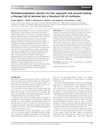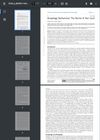New cure? A new combo to dream with hair regeneration Research/Science 6/11/2025
A stem cell and adenosine triphosphate cocktail showed promising results in hair regrowth for male and female mice, with potential for future clinical trials. Users humorously reacted to the success in mice, expressing hope for human application.
View this post in the Community →
Similar Community Posts Join
5 / 520 resultscommunity I think we should all keep an eye out for Pelage PP405. February 2025 will be interesting.
Pelage PP405 is a new hair loss treatment in trials, potentially reactivating dormant hair follicles without affecting hormones. Results are expected in February 2025, offering an alternative to minoxidil and finasteride.
community IT ABSOLUTELY FUCKING SUCKS to be going through this in silence while my roommates/best friends don't have to worry about this.
The conversation is about a person struggling with hair loss and feeling frustrated comparing themselves to friends with thick hair. They started taking 1 mg Finasteride a month ago to address the hair loss.
community 30-Min Dermatology Visit – Best Questions to Ask About Balding? ( 175$ )
The conversation discusses hair loss treatments, focusing on finasteride, minoxidil, and other options like PRP and ketoconazole. It highlights the importance of asking specific questions during a dermatology visit to determine the cause of hair loss and appropriate treatments.
community Physio-metabolic method of treating androgenic alopecia. Cold receptors. The relationship between DHT, cold receptors, minoxidil and antiandrogens.
A method for treating androgenic alopecia using minoxidil, antiandrogens, exercise, and cold exposure to promote hair growth. Environmental factors and lifestyle changes, like diet and exercise, can improve treatment effectiveness.

community Physio-metabolic method of treating androgenic alopecia. Cold receptors. The relationship between DHT, cold receptors, minoxidil and antiandrogens
Treating androgenic alopecia with minoxidil, finasteride, and antiandrogens, alongside exercise, cryotherapy, and natural substances to stimulate cold receptors for better hair growth. The method focuses on enhancing treatment effectiveness by considering environmental and behavioral factors and the role of cold receptors and muscle stress.
Related Research
6 / 1000+ resultsresearch A Decade of Autologous Micrografting Technology in Hair Restoration: A Review of Clinical Evidence and the Evolving Landscape of Regenerative Treatments
Autologous Micrografting Technology effectively improves hair growth and is a safe, promising option for hair restoration.

research Photobiomodulation Devices for Hair Regrowth and Wound Healing: A Therapy Full of Promise but a Literature Full of Confusion
Photobiomodulation may help with hair growth and wound healing, but research is inconsistent and needs better quality studies.

research Ingredients of Trichological Shampoos with Alleged Beneficial Effects on Hair—What Is Really Known About Their Efficacy? A Scoping Review of an Area with More Unknowns than Knowns
Most trichological shampoo ingredients lack strong evidence for effectiveness against hair loss.
research Platelet-Rich Plasma in Dermatology: Cellular and Molecular Mechanisms of Action
PRP therapy helps skin heal and improve by promoting cell growth and repair.
research Physical Treatments and Therapies for Androgenetic Alopecia
Low-level laser therapy is the most supported treatment for hair loss, but other methods show promise.

research Autophagy Dysfunction: The Kernel of Hair Loss?
Manipulating cell cleanup processes could help treat hair loss.